Manchester United currently sit fourth in the FAWSL in their first campaign in the top flight. As United find their footing and look to build a foundation that sees them playing in Europe, a key player has emerged. Through tactical analysis, we can see Leah Galton has given the United squad an attacking asset that has helped to push the Reds into the upper tier of the first division. After analysis, we can see that Galton’s individual ability aids in expanding United’s attacking tactics. This scout report will look into just how Galton adds to the Manchester United attack.
Background
Born in Harrogate, England, Galton was quickly found by Leeds United at age 14. It took only two years for Galton to move into the first team and she made herself known with her first goal in September 2010 at age 16. In 2012 she took her talents to Hofstra University, just east of New York City. With Hofstra, Galton tallied 122 points ( 2 points per goal, 1 point per assist) over her college career which remains the highest tally in program history.
Galton was drafted by Sky Blue FC in the second round of the 2016 NWSL draft. In the 2016/17 campaign, Galton created an immediate impact leading the team in assists and tying for third place in goal contribution. In 2017 Galton signed with Bayern Munich, but by March 2018 had announced that she would be taking a break from football.
Galton has also been capped internationally with England with the U-17 and U-19 teams. Galton was called up to the England first team in August 2016 but had to pull out due to a hip injury.
In July 0f 2018 it was announced that Galton would be joining Manchester United in the club’s reintroduction into women’s football. Galton aided the team in achieving a first-place finish and automatic promotion from the FA Women’s Championship to the FAWSL.
Attacking 1v1s
Galton can be considered an attacking left-winger who is quite comfortable staying on the left side of the pitch. Throughout her career, she has achieved an average of 6.8 1v1 dribbles per 90’ giving us a caricature of a player who is comfortable attacking defensive players directly. To date, she has a quite high 87.3% success rate and a 94.7% success rate specifically against opposing centre-backs.
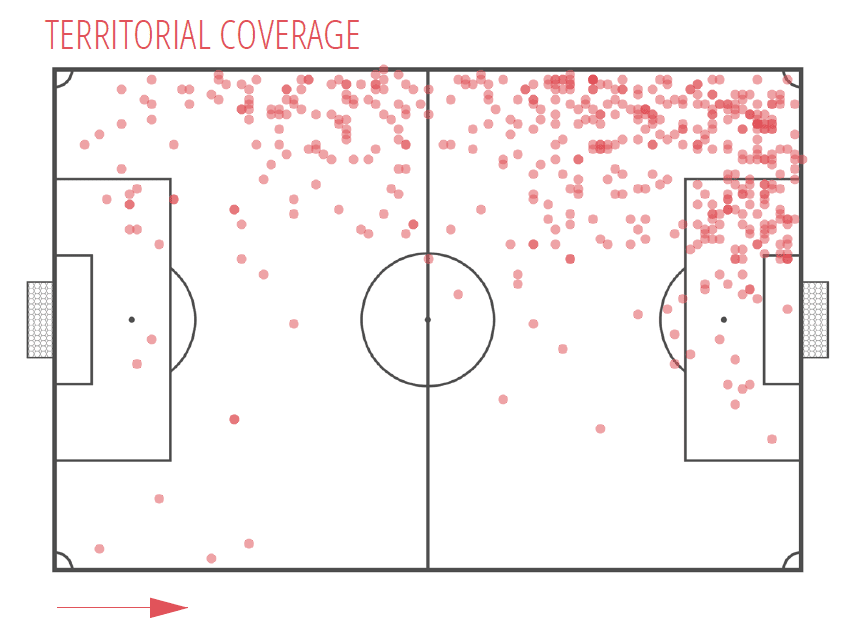
This has led Galton to rank in the top three in the FAWSL when it comes to touches in the opposition box with 5.73 per 90’. Additionally, during the 2019/20 FAWSL campaign she ranks number six in dribbles per 90’, but leads the way with a 71% success rate. For perspective, this is about the same success rate as Mason Greenwood, who leads the men’s Manchester United attackers.
Galton is able to achieve these statistics with a combination of core attacking 1v1 skills: Change of speed, change of direction, body feints and outright physicality. Change of speed and change of direction cannot be executed effectively in isolation. But when paired together at a high level, they can be quite the problem for opposing defenders.
Galton is also comfortable attacking defenders while moving at high speed, which can create additional problems for defenders who do not have an angled and low body orientation. Add effective body feints, in which Galton can deceive the opposition and you have a potent attacker.
In Manchester United’s last fixture before the league was suspended, we see an excellent example of Galton using her 1v1 skills. Below we see a moment in which Manchester United have moved the ball to the left flank. As Galton receives the ball, Everton are set in fairly good positions to restrict and pressure the United presence on the flank.
Galton, faced with immediate pressure from Everton right-back Esme Morgan, chooses not to pass backwards and recycle possession, but to aggressively enact a series of 1v1s. Galton shifts the ball to her left to draw Morgan with it. In a quick burst, Galton shifts the ball across the defender to her right side with the inside of her left foot. Galton then takes a touch forward to accelerate past Morgan. In the image below you can see that Galton is already moving to her right while Morgan is still leaning to the left and reacting to the initial feint.
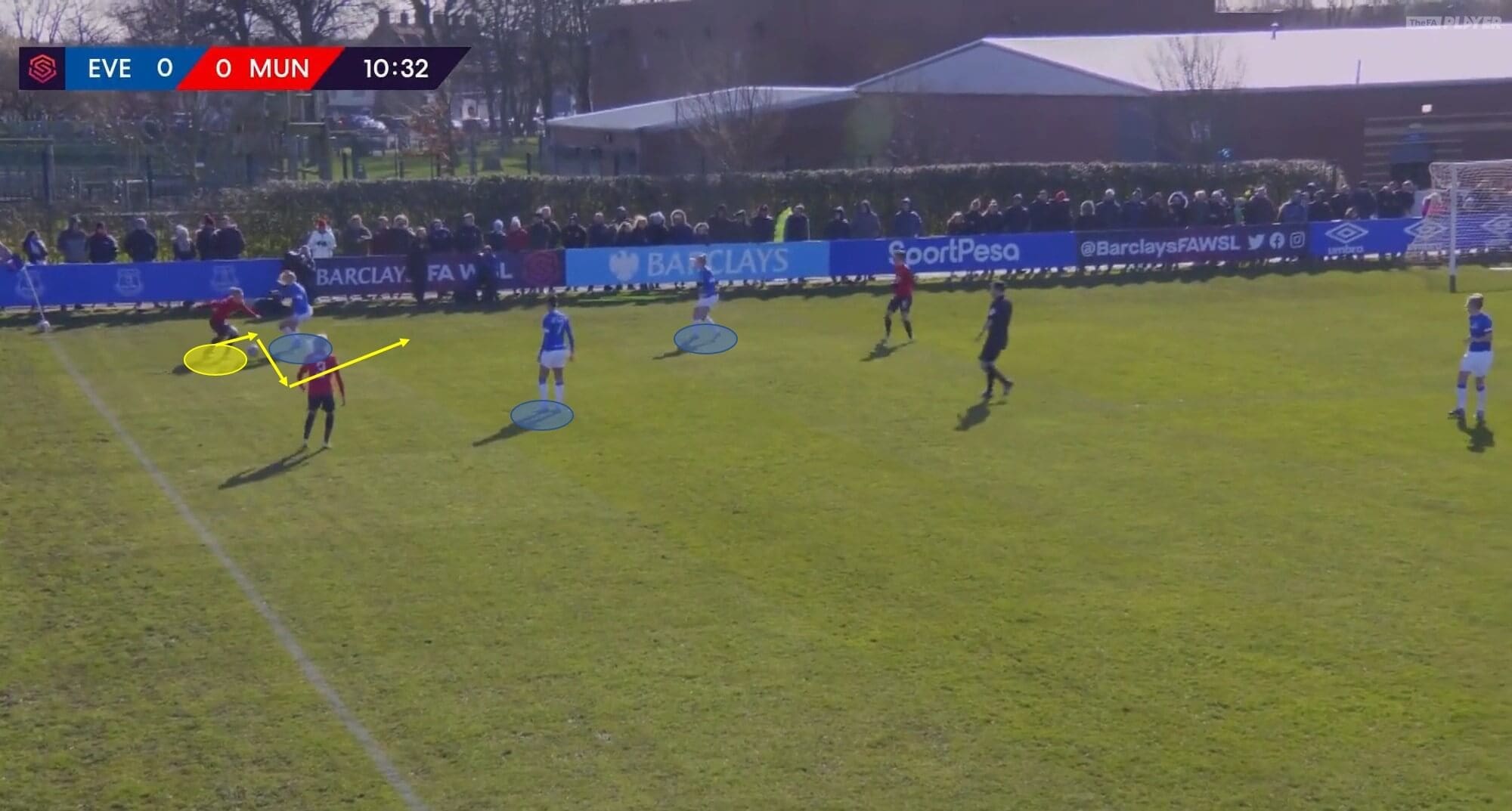
Galton continues past the first defender and opts for another 1v1. She feints to her right by dropping her shoulder in that direction while simultaneously moving at high speed. The defender, who is flat-footed and has her shoulders facing forward, is unable to react in time. In the image, we can see the defender has her left foot planted and is leaning in that direction while Galton is already moving around her other side.
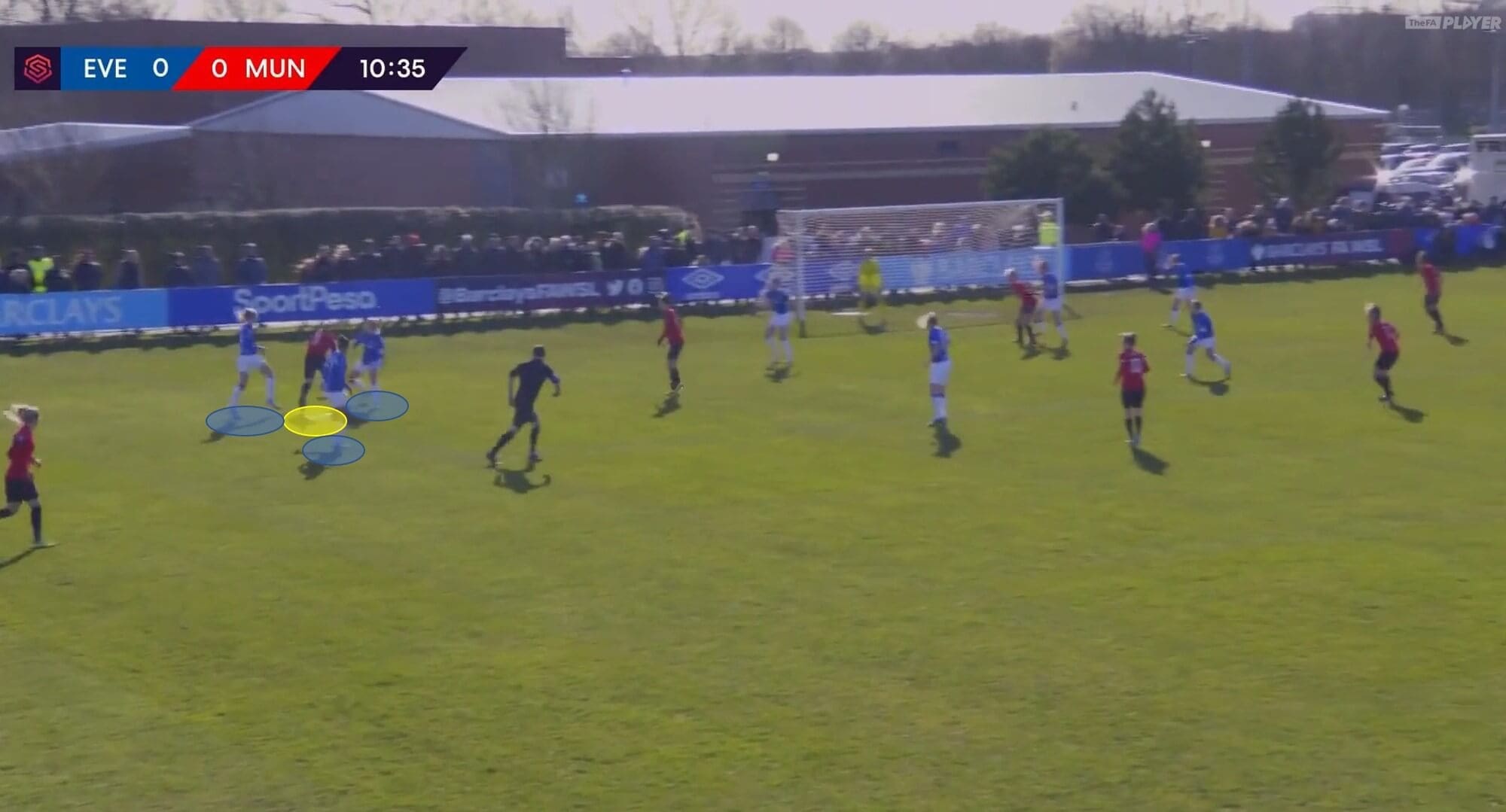
Now that Galton has accomplished two attacking 1v1s we can see that she has not only moved the ball closer to the goal but has also drawn four defenders near her. In this moment Galton has drawn enough pressure to leave four Everton players defending the centre of the box. Manchester United now have a 5v4 attacking overload in the opponent’s box almost completely due to Galton’s dribble from the corner flag.
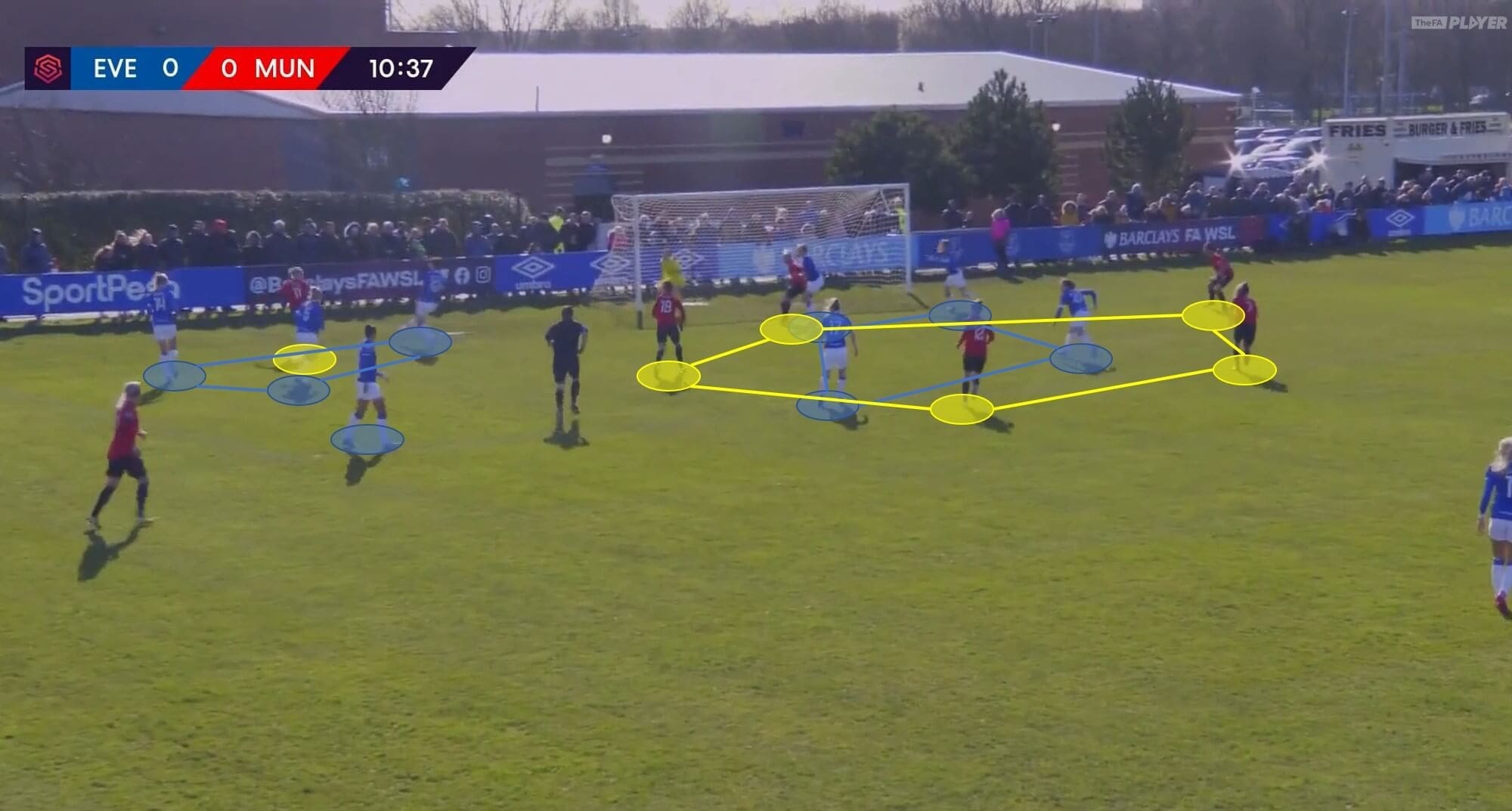
Galton is very much able to create attacking plays out of nothing. Her aggressive and front-footed approach is a vastly under-rated facet of United attacking play.
Crossing
In addition to creating attacking chances through her dribbling, Galton is also able to create chances through different forms of crossing. Galton currently ranks number two in the league in crosses with a high success rate of 42% (only one player in the top ten has a higher success rate). Galton’s success rate can partly be attributed to the fact that she allocates both high and low crosses within her arsenal. Another reason for her success rate can be seen in that Galton’s 1v1 ability forces defensive units to heavily focus on her, which helps teammates to execute blindside runs to receive the crosses.
Over her career, she has produced an almost even split between the two cross types with 46.67% high crosses and 53.33% low crosses. This may sound trivial, but each type of cross requires different skillsets and each have different tactical implications. Knowing that Galton does not specifically lean towards one type of delivery over the other makes her more versatile and dynamic. The more versatile the attacker, the more of a headache she can be for defending units.
High crosses are the most common form of cross delivery and for sake of article length, we will not dive into chipped vs inswinging vs outswinging. These type of deliveries can be used to probe positional weaknesses and stretch out defences. What makes high crosses difficult to execute is the variables that are involved in achieving a successful high cross.
Firstly, the teammate the ball is being delivered to should hypothetically have some sort of height advantage over the nearby defenders as well as proficiency in aerial ability. Additionally, weather can be an additional factor that significantly inhibits a player’s ability to deliver a high cross through the air. It must also be said that delivering a quality high cross demands a high technical ability, especially when delivering the ball while sprinting.
Conversely, low crosses offer less negative variables and can instead use chaos to its benefit. The delivery from the crosser is much easier because it demands a low driven ball, which gives the crosser more control and accuracy. Teammates tend to have an easier time receiving low crosses because they are able to use their feet to receive the ball as opposed to using their head and possibly a jump. The real beauty of low crosses is that, if it is executed while players are moving towards the target goal (including defenders) any deflections tend to go forward towards the goal. This means that if a ball is deflected by a defender it usually goes out for a corner or past an unsuspecting keeper into the goal.
Below we can see Galton’s crossing versatility on display vs Tottenham last October. In the fifty-first minute, Galton is faced with two direct defenders. Unsurprisingly, she chooses to burst past both of them towards the Tottenham goal line.
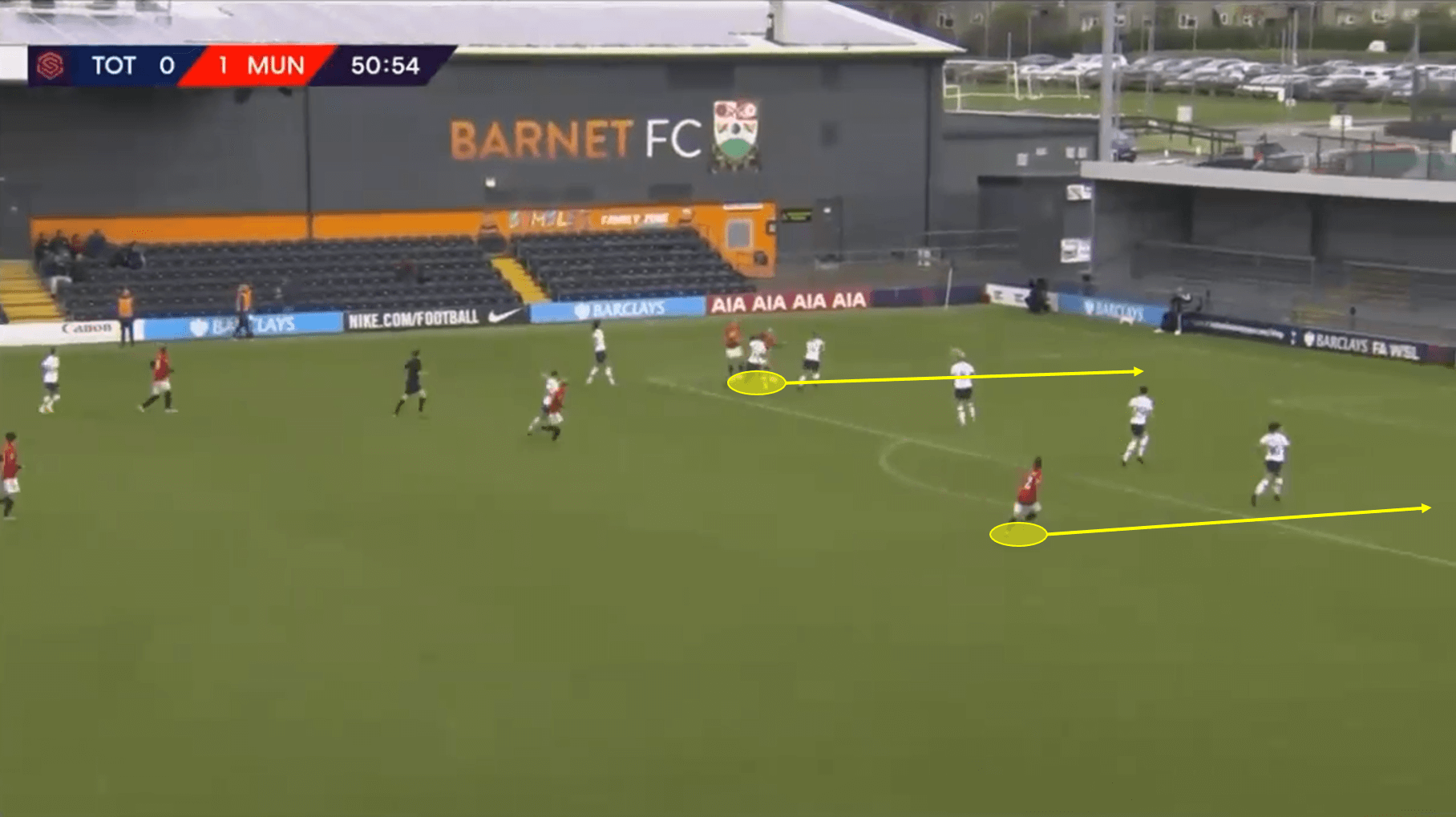
Having created space to execute a low cross with her burst of speed. Galton rips a driven ball towards the back post. Realistically there is very little chance that the low cross is going to make it through five Tottenham defenders, but it does not matter.
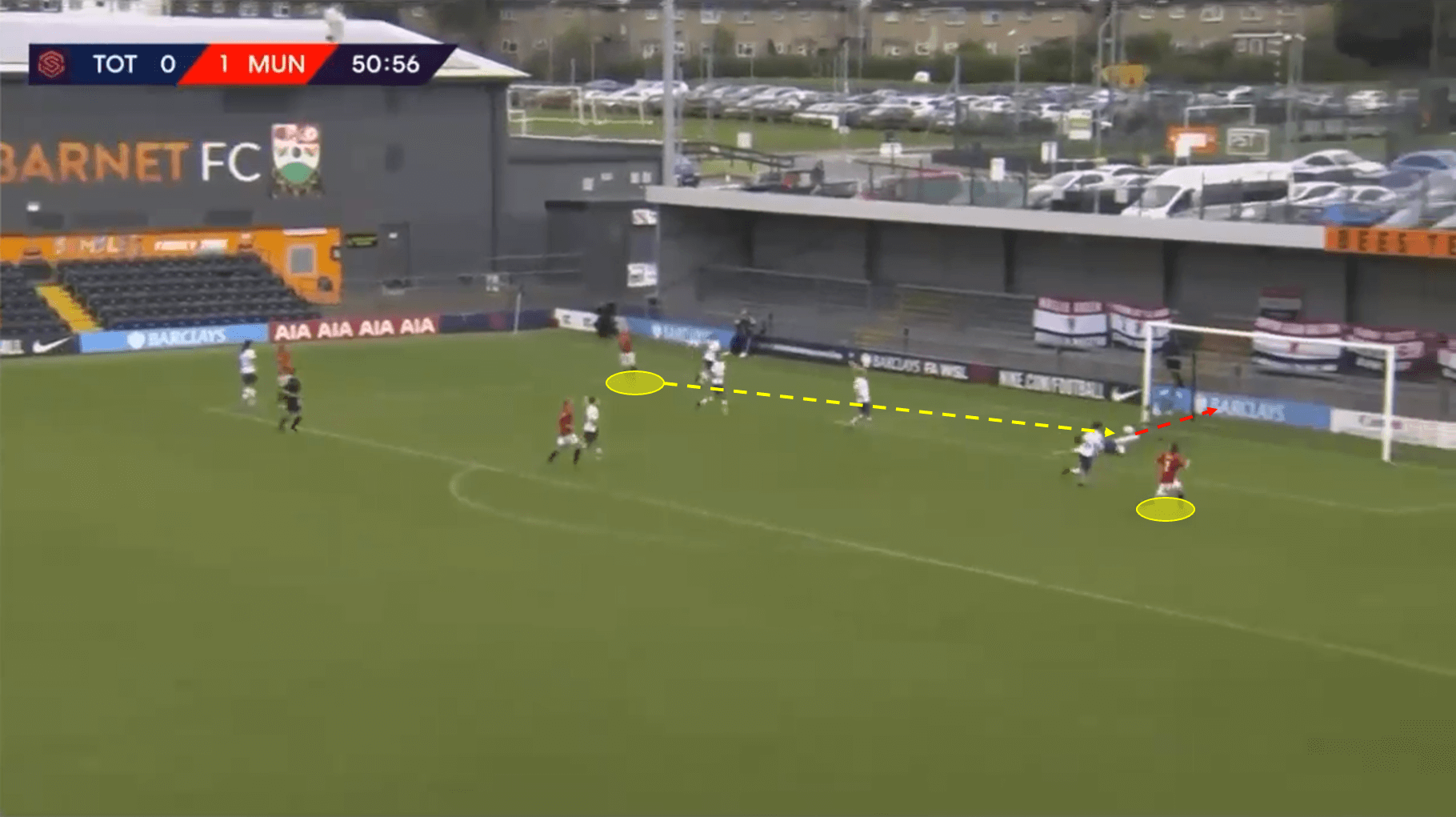
Tottenham defender Ashleigh Neville attempts to block the cross and accidentally knocks the ball into the back of her own net. Does it count as an assist on Galton’s scorecard? No, but did Galton create the goal? Absolutely.
Later in the match, we can see that Galton has penetrated into the box, prompting the Tottenham defensive line to shift aggressively in her direction. Her aggressive dribble paired with the memory of her earlier low cross has created a pocket of space for advancing right-back, Martha Harris. In this moment, Harris will have a large amount of space to work with and Galton chooses to execute a high cross.
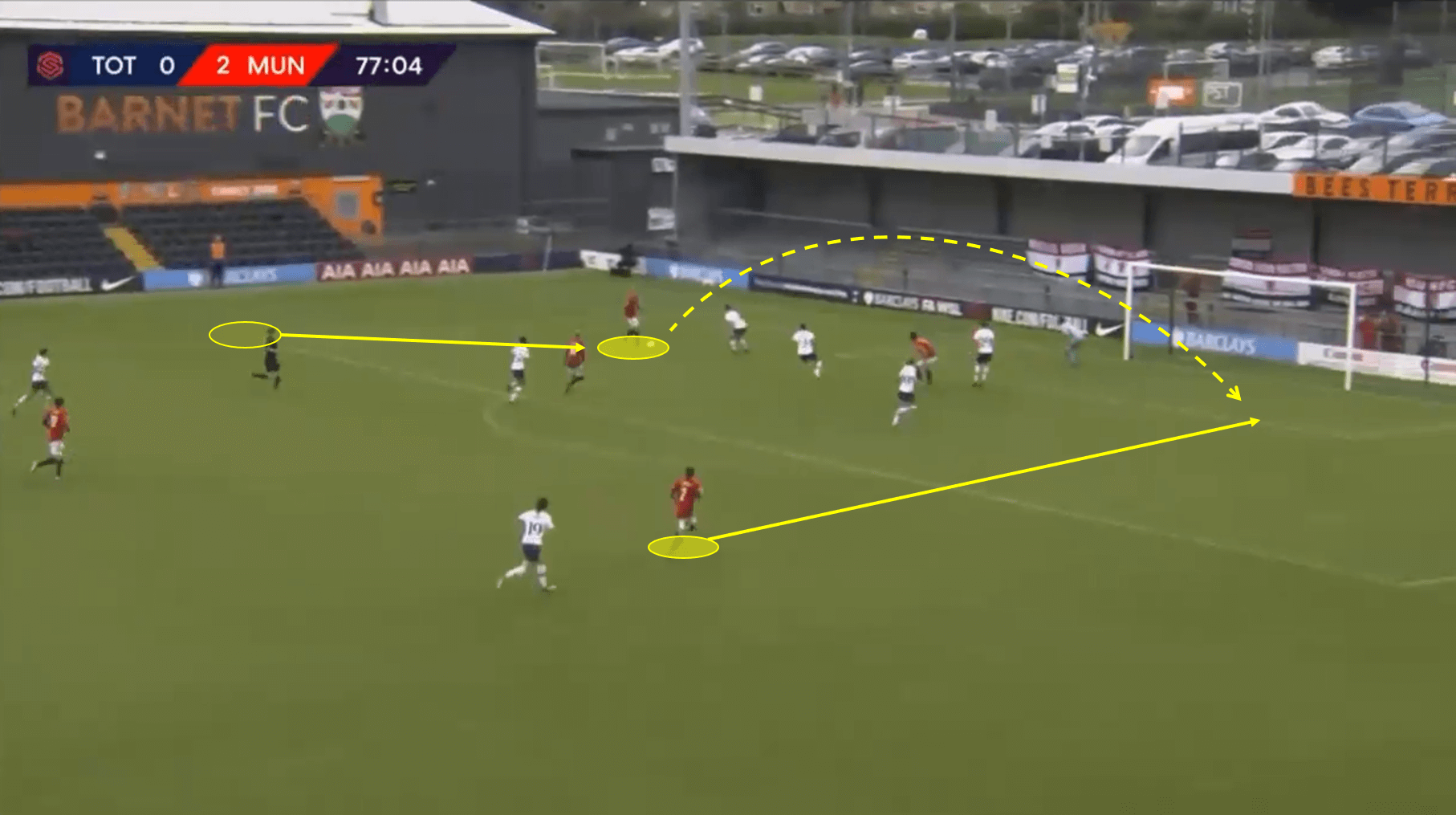
Unfortunately, in this specific example, the ball does not create a clear chance on goal. Although, we are able to see that the threat of two different types of crosses can be used to disrupt and disorder opposing defensive unit in their own box.
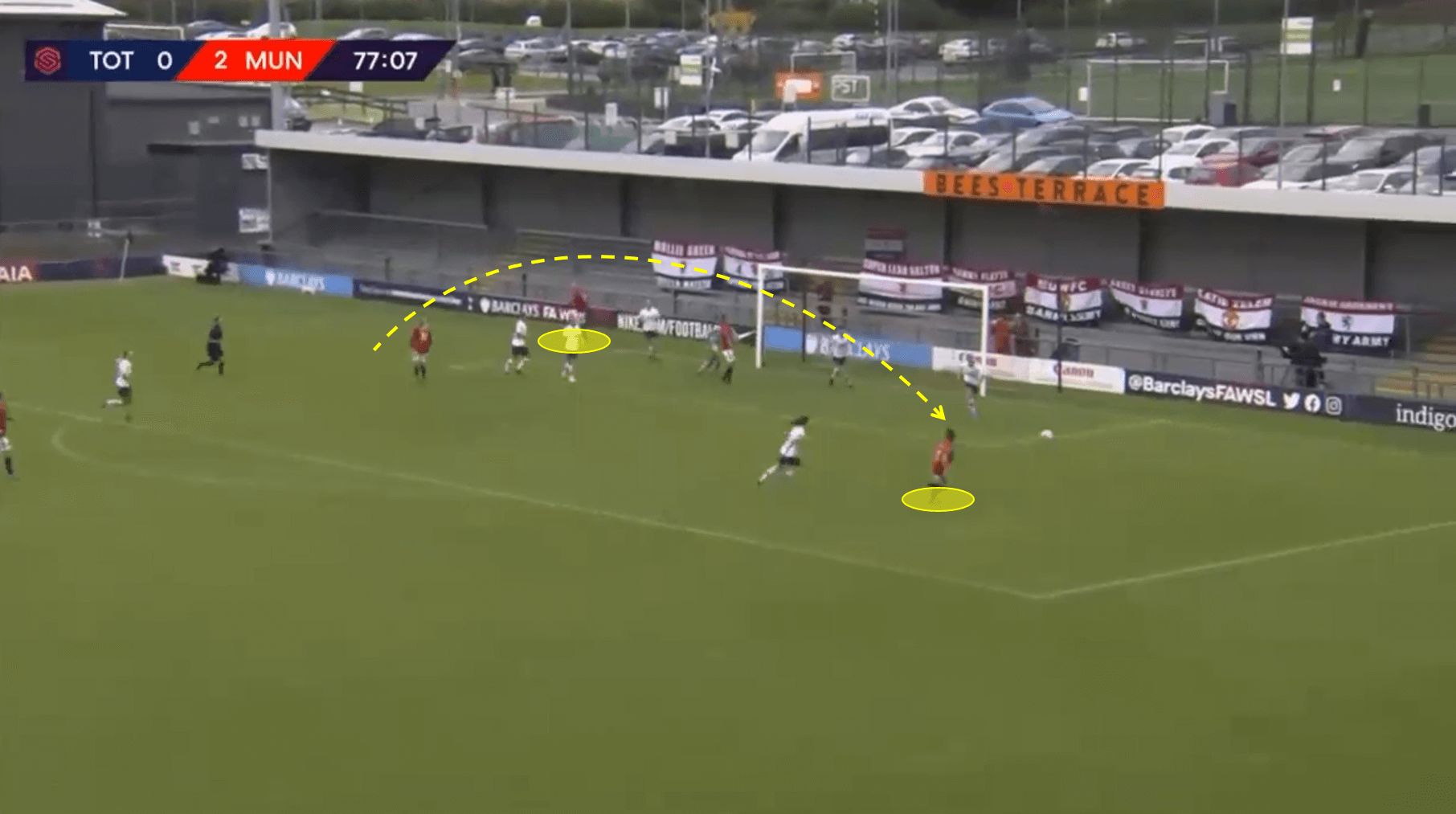
By balancing the threat of attacking 1v1s, low crosses and high crosses, Galton is able to keep defensive units always guessing as to her potential actions. This is looking at her in individual circumstances. Her abilities as an attacker and assist creator also pay dividends for the entire United team.
Inversion
Galton also uses her position as a weapon to open up a plethora of attacking options for her attacking teammates. By inverting into the halfspace in attack, Galton is able to use her attacking 1v1 and passing skills to individually threaten defensive blocks as well as create potential attacking platforms for her teammates. Ian O’Neill covers this brilliantly in TFA’s April magazine which has been produced into a video by Max Bergmann, although in this example the positions will be slightly different.
Firstly, as Galton receives the ball in front of the defensive line in the halfspace, the opposing right-back is typically left with two options. She can close down Galton and initiate a 1v1, which will open up space to exploit in the defensive line. Or she can remain in step with her defensive line to retain the team shape but allow Galton to advance into the attacking third. Neither of these options is optimal.
In addition to the Galton/right-back interaction, the rest of the United attacking unit can take advantage of Galton’s inversion into the halfspace. All of the following actions can happen simultaneously. Galton’s inversion occupies the opposing right-back in the halfspace, which allows an advancing United left-back to move high into the left flank unopposed. This creates a numerical superiority with a 2v1 against the opposing right-back.
The forward can push high and pin back the opponent centrebacks while also acting as an outlet for a through or chipped pass behind the defensive line. A fellow forward or central attacking midfielder can move into the space left behind the opposing right-back. Because of the forward attacking runs, typically space is opened up in the centre of the field for a central midfielder to drop into. Finally, the far side fullback, in this case, the United right-back may advance high into the space of her choice using her position on the opposing team’s blindside to her advantage.
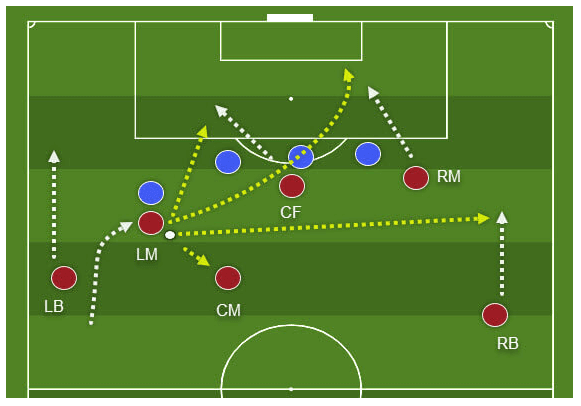
Below, we can see a near-perfect example of this team attacking tactical movement in the match against Everton. Galton is advancing into the left halfspace and has initiated a confrontation with Morgan. Morgan chooses to close down Galton. Jane Ross continues her sprint forward in the central channel to pin back the Everton centre-backs and possibly receive a through/chipped pass. Jackie Groenen makes a diagonal run into the now vacant space left behind by Morgan.
Ella Toone cuts in horizontally to provide a central attacking option. Finally, both Lotta Ökvist and Kirsty Smith streak forward as attacking fullbacks.

The major takeaway from this situation is that this attacking tactic would not be nearly as effective without Galton. Galton’s ability to win 1v1s and use different techniques to successfully deliver the ball to different channels on the pitch allows United to facilitate multiple off-the-ball attacking runs. All of the off-the-ball runs are feasible options. Galton elevates the entire team.
Conclusion
As the season stands, United sit fourth in the table. They have a little ways to go to catch the trifecta of Arsenal, Chelsea and Manchester City. Manchester United are adapting to the first division quickly and Galton looks to be a key component moving forward. Barring any additional injury setbacks, we can be sure that Galton will be a force to be reckoned with in the FAWSL.

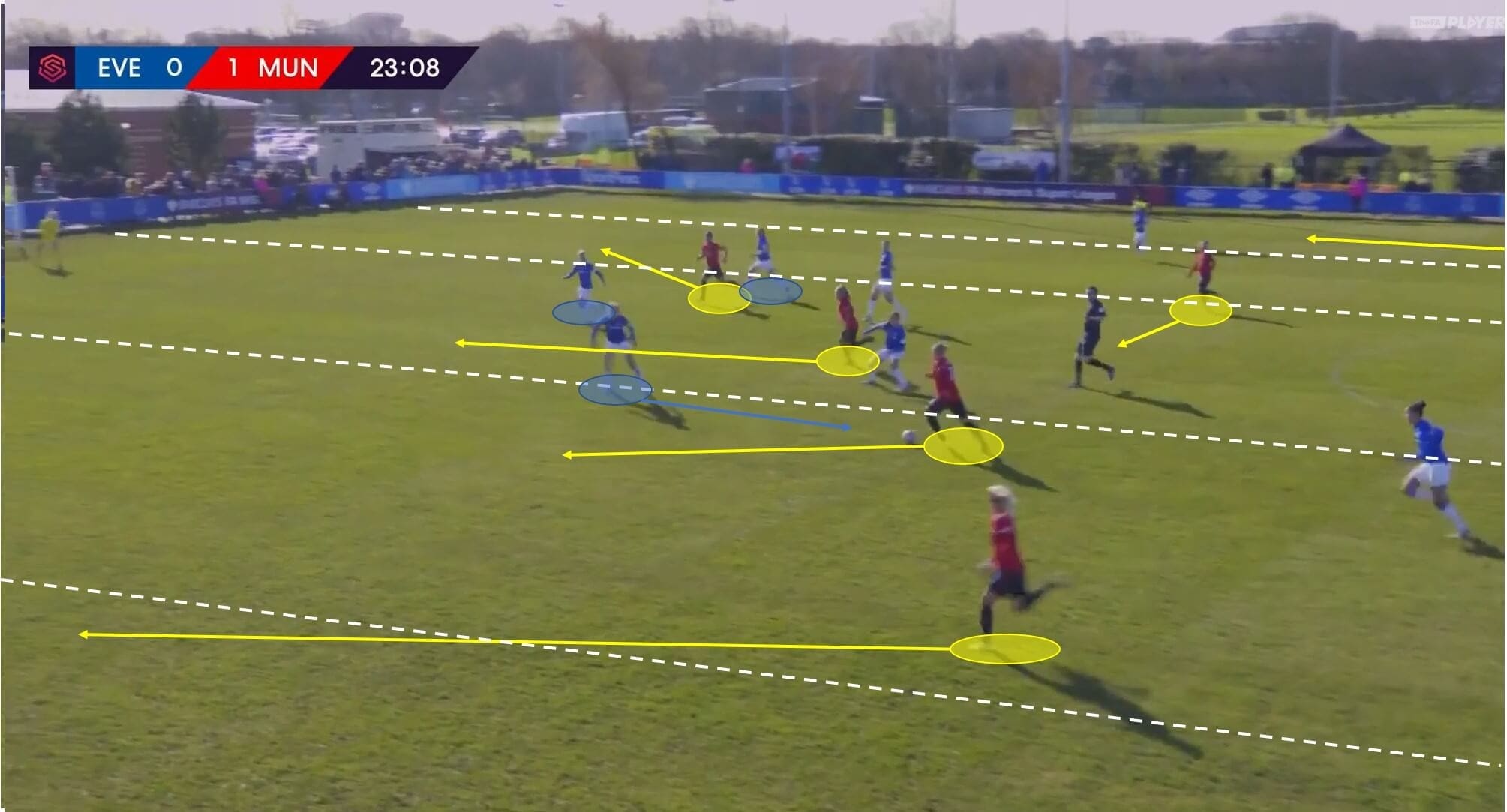



Comments